In 1565 the Dutch painter Pieter Bruegel (Breda, c. 1525-Brussels, 1569), at the height of his career, produced a series of paintings devoted to the theme of the months of the year for the wealthy merchant Niclaes Jonghelinck, who later had to give it to the city of Antwerp. From the city, years later, the works were donated to Archduke Ernest of Austria. Currently, of the five panels that have come down to us, three are kept at the Kunsthistorisches Museum in Vienna (where the largest number of the artist’s paintings is collected), one in Prague at the N<árodn<í Galerie, and one at the Metropolitan Museum of Art in New York.
The series was in keeping, though declining in monumental terms, with the medieval tradition of illustrated calendars with scenes depicting the various human activities carried out in the ineluctable succession of the seasons.
We do not know with absolute certainty what the number of paintings was originally (whether six or twelve), although most scholars today believe that Bruegel made six, one for the bimonths of each season. And, on the understanding that traditionally the months were depicted individually and that the joining of two would have been not unprecedented but rather unusual, the inventories that have come down to us would seem to confirm this hypothesis. On July 5, 1594, the secretary of Ernest of Habsburg recorded six, “in each picture two months with their respective figures”; a century later in an inventory of the estate of Archduke Leopold Wilhelm five plates turn out to be the ones that have come down to us. Also because of this uncertainty, it is not very easy to determine precisely which month or which pair of months each plate refers to.
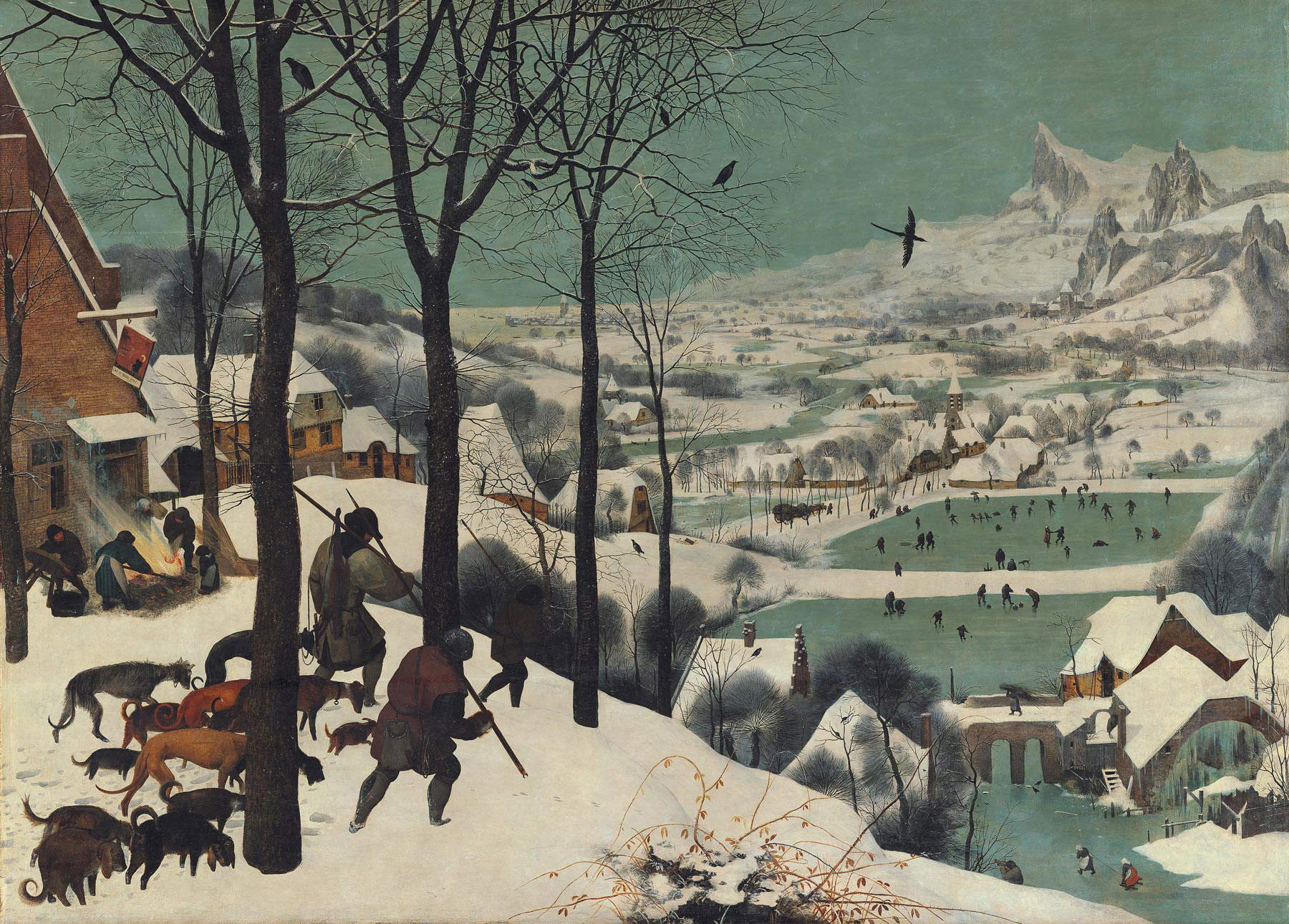 |
| Pieter Bruegel, Hunters in the Snow (1565; oil on panel, 116.5 x 162 cm; Vienna, Kunsthistorisches Museum) |
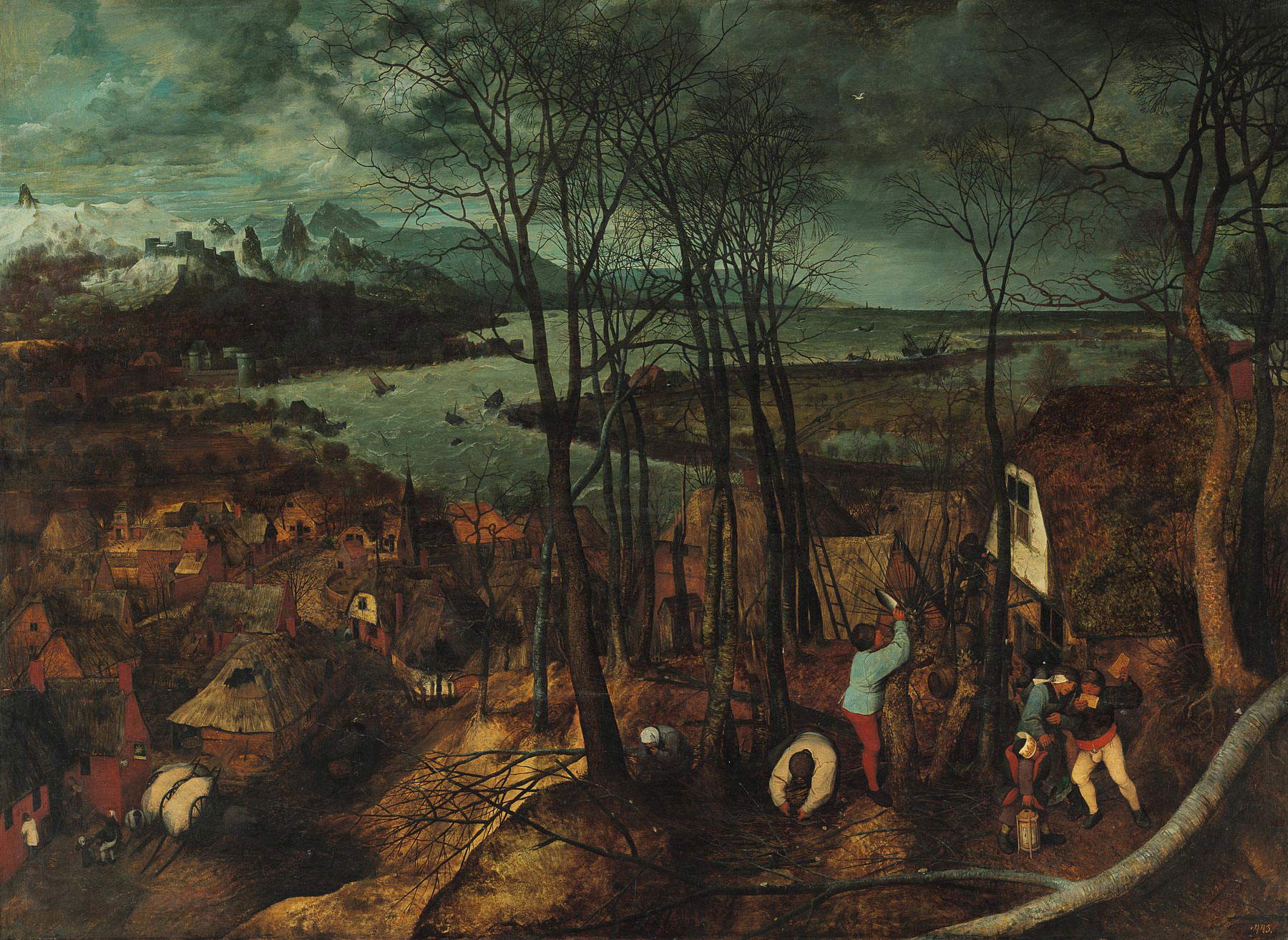 |
| Pieter Bruegel, The Dark Day (1565; oil on panel, 118 x 163 cm; Vienna, Kunsthistorisches Museum) |
 |
| Pieter Bruegel, The Haymaking (1565; oil on panel, 117 x 161 cm; Prague, Národní Galerie) |
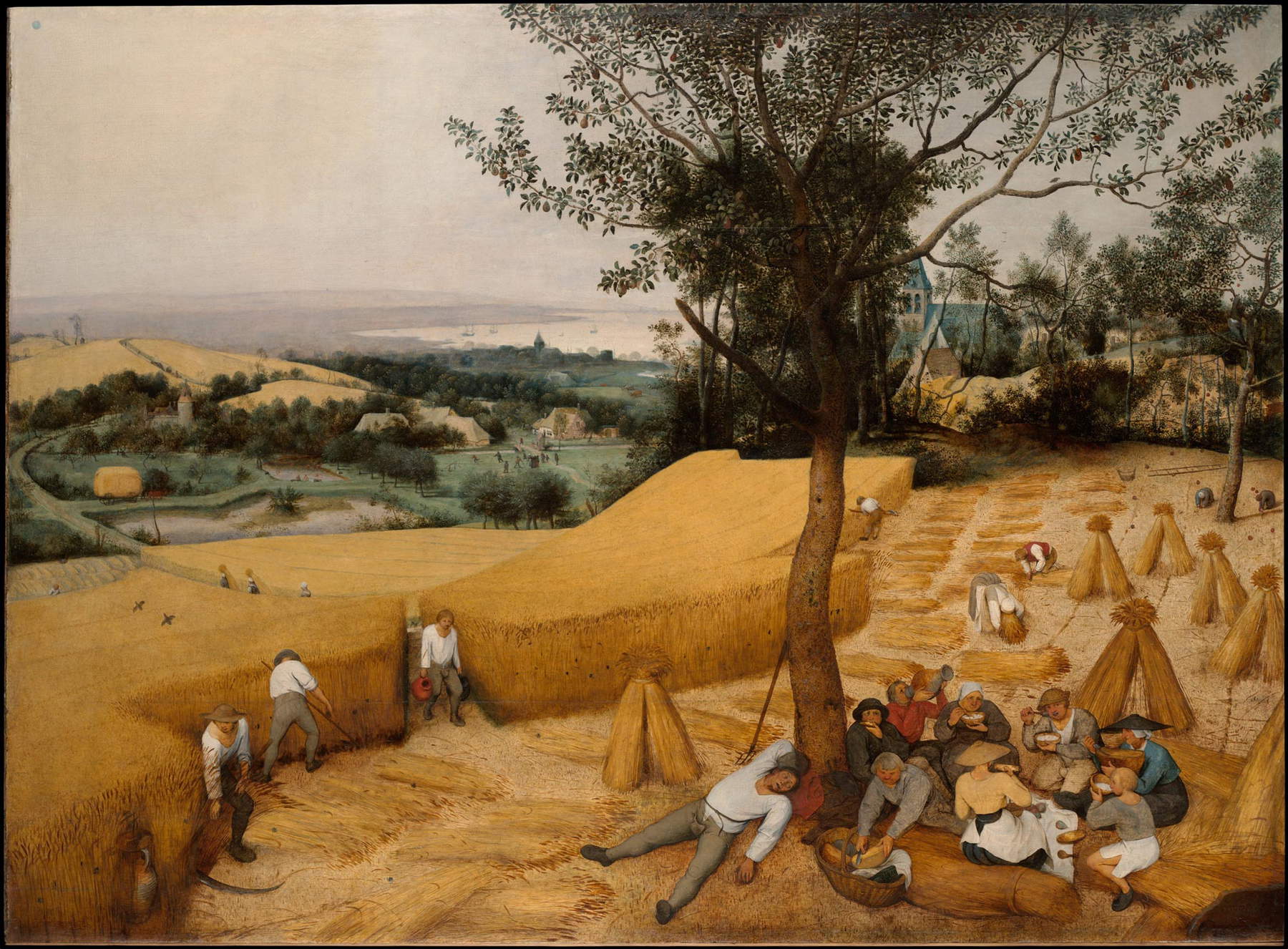 |
| Pieter Bruegel, The Reaping (1565; oil on panel, 119 x 162 cm; New York, The Metropolitan Museum) |
 |
| Pieter Bruegel, The Return of the Herd (1565; oil on panel, 117 x 159.7 cm; Vienna, Kunsthistorisches Museum) |
Generally Hunters in the Snow is considered a depiction of December or January or the bimonthly December-January, The Dark Day is believed to depict February or February-March, The Haying June or June-July, The Harvest August or August-September, and The Return of the Herd October or November or again October-November. If the six-painting hypothesis is taken at face value, the painting mentioned by the 1594 inventory and then disappeared could have referred to the April-May bimonth. However, art historian Alexander Wied, who nonetheless considers the cycle to consist of six works, observed in his 1980s monograph on the painter that “we can depart for a moment from calendar depictions and consider Bruegel’s cycle revolutionary, not least because he captured in a free succession, which is not the usual succession of the four seasons, six different aspects of nature, without thinking of a rigid time limitation.”
In the Dutch painter’s paintings, the succession of the seasons is witnessed no longer primarily by the activities of men, but primarily by the landscape; overwhelmed, in a grand and sovereign nature that constantly changes, human beings swarm, often bustling “in the recurring vicissitude of life,” to use Arturo Bovi’s words from his 1970 “Bruegel.”
Thus in La giornata buia (The Dark Day), under a sky laden with dark clouds, in the foreground but relegated to the right, a group of peasants work around some trees, while in the distance some boats sink yielding to the stormy sea. In contrast The Haymaking, with its clear atmosphere, shows us the beginning of summer and opens into a vast landscape whose colors vary from the yellow and green of the lower part, populated by peasants, to the blue of the hills and river. Again yellow, this time much more intense, dominates the depiction of the fields in The Harvest, in which the laborers toiling in the left part of the painting, defined at the bottom by a uniform golden expanse, are answered by those lying on the ground eating or sleeping, in the opposite, chromatically more articulate part. No one rests, on the other hand, in the painting The Return of the Herd in which the slow march of men and animals in the foreground expresses cold and fatigue, while in the background we are shown all the atmospheric hostility of advanced autumn.
Hunters in the Snow, probably the first painting in the series, is also the best known and certainly one of the best known pictorial representations of winter ever. Like the other four paintings, it is an oil on panel and like the others, with the exception of The Haymaking, is signed and dated; it measures 117 cm by 162.
In the foreground three hunters advance through the snow, not without effort, with their spears, and one of the three carries a slain fox. They are followed by a pack of dogs shivering from the cold. Farther to the left, next to an inn whose sign with St. Hubert (protector of hunters) we see on the roof, a group of people are preparing everything necessary for the shucking of the pig: the animal is not there, but the fire and the wooden tub unmistakably indicate what is about to happen.
From that area steep slopes lead the gaze downward to the frozen ponds on which some skaters frolic, some entertain themselves while playing, some fall. In the center of the composition, in the distance, placed next to the fourth of the trees succeeding each other from the point where the dogs are, we see a tiny brown spot on the snow: it is a bird trap surrounded, indeed, by birds. On the other side a bridge, on which a figure carrying faggots walks, crosses the pond skirting a ruined mill covered with ice. Also on the right, down along the line of the slope, we glimpse a man working around bare branches, while not far from him two women skate on the frozen water.
In front of the hunters is the valley, with its snow-covered lanes, ponds, houses, and bell towers; above flies a solemn and silent raven, while others stand still on the bare branches that crowd, intertwining, the left top of the depiction. Still to the left are shown the frozen shores of the sea whose light green water stands out against the darker sky, against which, on the opposite side, the peaks of some mountains stand out.
 |
| Pieter Bruegel, Hunters in the Snow, detail of the hunters and, in the background, the people in front of the inn |
 |
| Pieter Bruegel, Hunters in the Snow, detail of the bird trap |
 |
| Pieter Bruegel, Hunters in the Snow, detail of the village and the pond in the background |
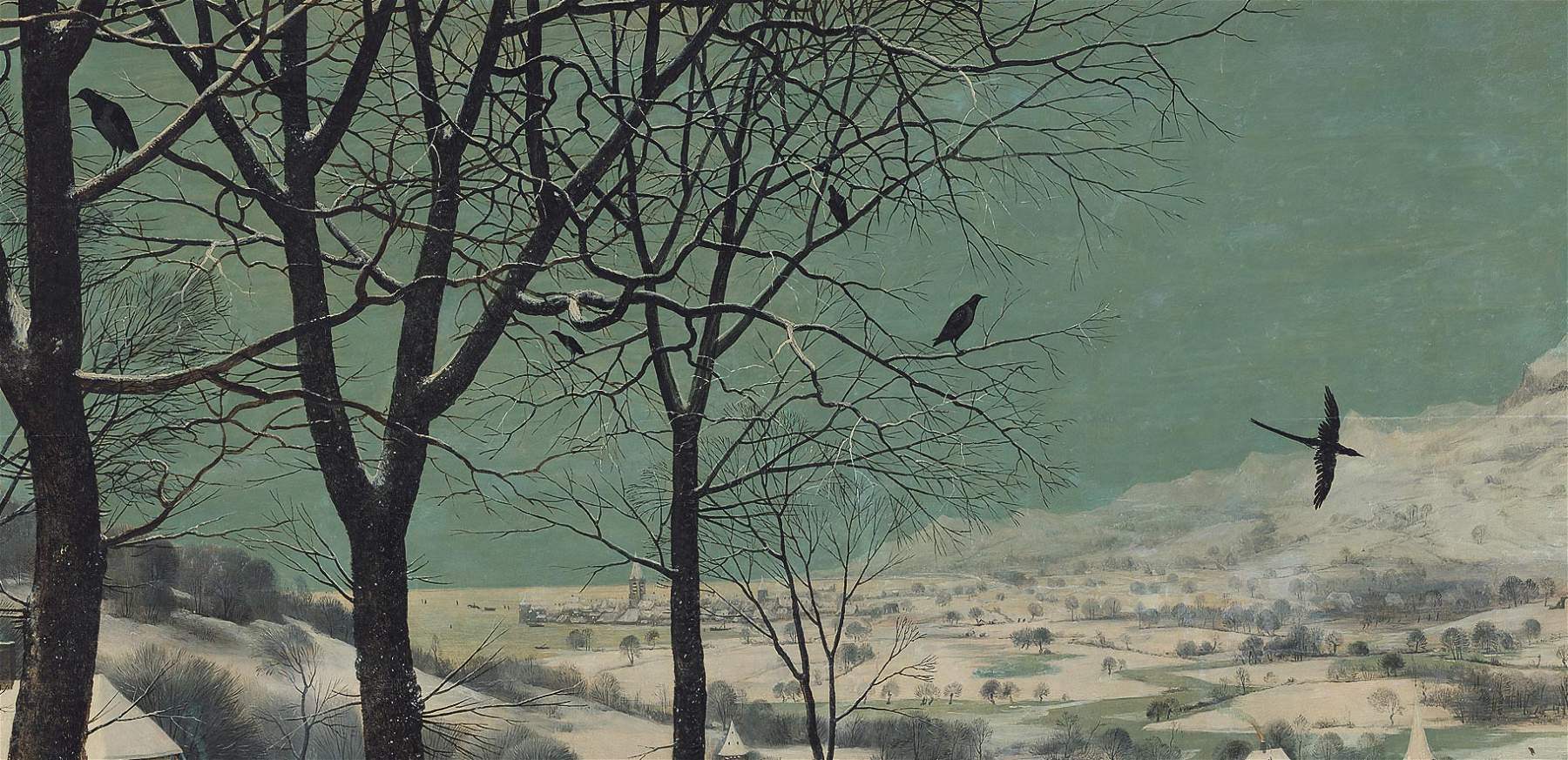 |
| Pieter Bruegel, Hunters in the Snow, detail of the crows |
 |
| Pieter Bruegel, Hunters in the Snow, detail of the mill in the foreground |
 |
| Pieter Bruegel, Hunters in the snow, detail of the mill in the foreground |
 |
| Pieter Bruegel, Hunters in the Snow, detail of the mountains |
In a very well-known passage in his Shilder Boeck, first published in 1604, the Dutch painter and biographer Karl Van Mander speaking of Pieter Bruegel and his formative journey to France and Italy, which he made between 1552 and 1554, says: “It is said of him that when he was in the Alps, he swallowed all the mountains and rocks and then vomited them up, when he returned home, on canvases and panels, so faithfully did he know how to approach the nature of this or that place.” And it is easy to imagine that such reminiscences, of which there is evidence in a large part of the artist’s pictorial and graphic production, think of the peaks in the aforementioned LaGiornatabuia or the majestic background of Escape to Egypt in the Courtauld Gallery, also came in well handy for him in the creation of the landscape in the painting under discussion.
But let us see further details. Both the skaters and the trap also appear in another famous painting by Bruegel also depicting a typical winter day, smaller in format and made in the same year: Winter Landscape with Skaters and Bird Trap, housed in the Musées Royaux des Beaux-Arts in Brussels. In this painting, a true prototype of the snowy landscapes in the context of 17th-century Dutch painting, the skaters frolicking on the frozen river occupy the central part, while the wooden board that constitutes the trap, resting on a stick and tied to a wire connecting it to a nearby house, is clearly visible (much more so than in Hunters in the Snow) on the right. The object’s prominent position and proximity to the skaters have led many scholars to speculate on a moralizing meaning of the work: the foiled and unsuspecting skaters are in danger of losing themselves to temptation, just as the birds are in danger of dying threatened by the trap.
Indeed, often in Nordic figurative art contemporary to Bruegel, birds, bird hunters, and the trap recur in allegorical depictions related to the themes of sin and perdition, in which the human soul is symbolized by a bird and the devil tempting it by its hunter. The roots of this tradition can be traced directly to the Bible. In chapter 124 of Psalms, for example, we read, “We were delivered like a bird from the snare of the hunters: the snare was broken, and we escaped.”
On the other hand, as far as skaters are concerned, many Flemish proverbs of the sixteenth century are known (and Bruegel’s interest in proverbs is undeniable; one need only mention the painting The Flemish Proverbs in the Staatliche Museen in Berlin) in which ice on the verge of breaking is a metaphor for danger or evil. Also at the Koninklijk Museum voor schone Kunsten in Antwerp is a print from a 1558 drawing by Bruegel himself, Skaters in front of St. George’s Gate in Antwerp (in private collection in the United States) accompanied by a moralizing inscription that relates the crowd on skates, depicted here, in which a man on the verge of falling stands out in the foreground, to the being, literally, slippery and therefore unstable of the human condition. The print is not an early state and there is no evidence that the artist was involved in its making, and yet it effectively testifies to how widespread among his cultural milieu was the metaphorical juxtaposition between ice and the moral precariousness of man.
In light of these considerations, the co-presence of trap and skaters in Hunters in the Snow is certainly interesting, for which there has been no shortage of readings emphasizing its possible allegorical implications.
Flemish proverbs Staatliche Skaters in front of St. George’s Gate in Antwerp
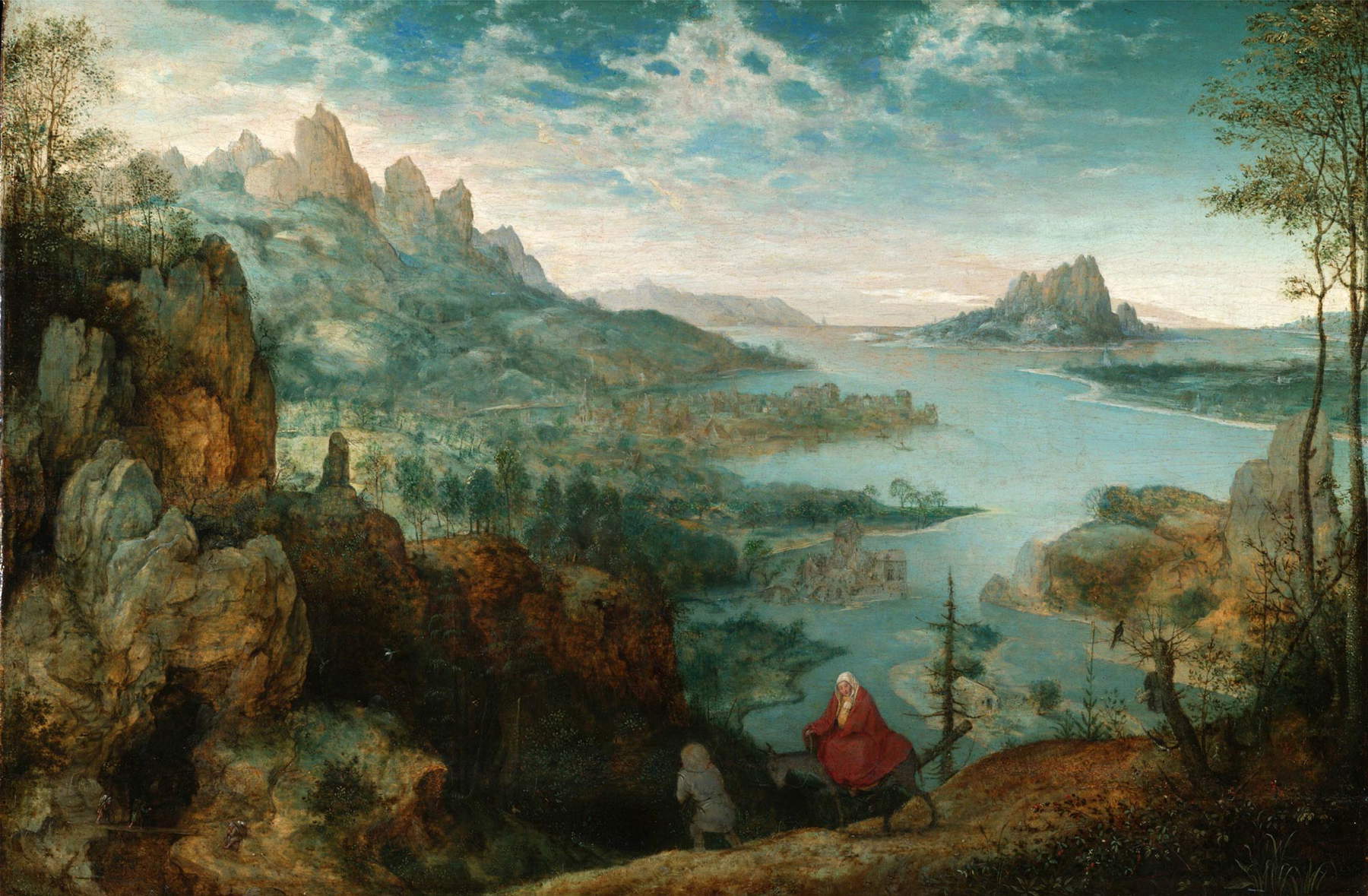 |
| Pieter Bruegel, Landscape with Flight into Egypt (1563; oil on panel, 37.1 x 55.6 cm; London, Courtauld Institute) |
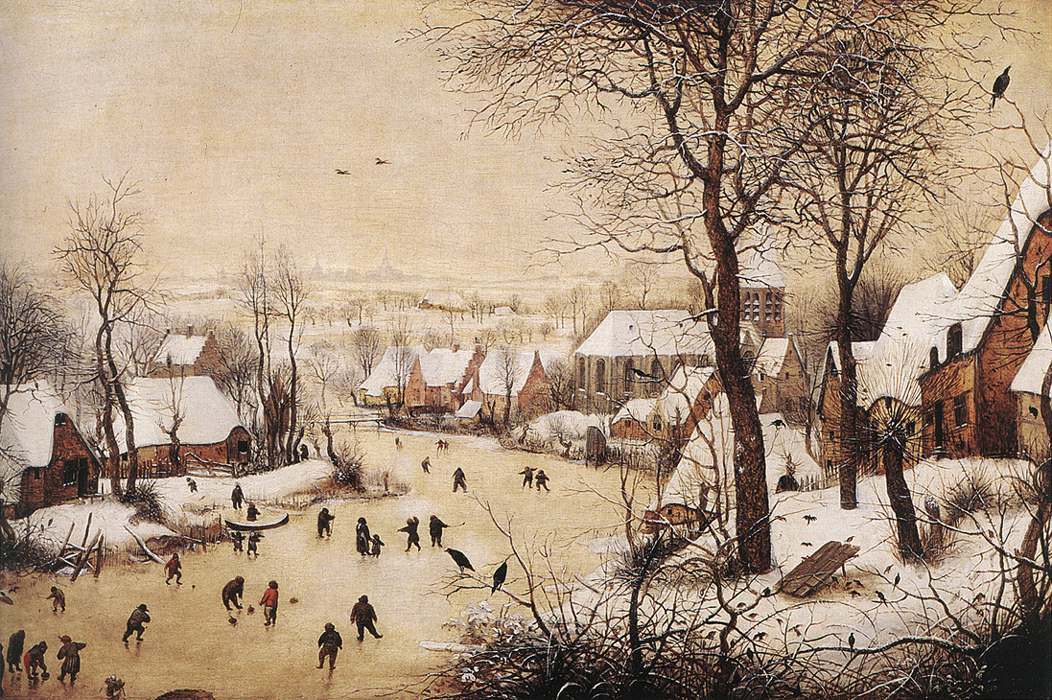 |
| Pieter Bruegel, Winter Landscape with Skaters and Bird Trap (1565; oil on panel, 37 x 55.5 cm; Brussels, Musées Royaux des Beaux-Arts) |
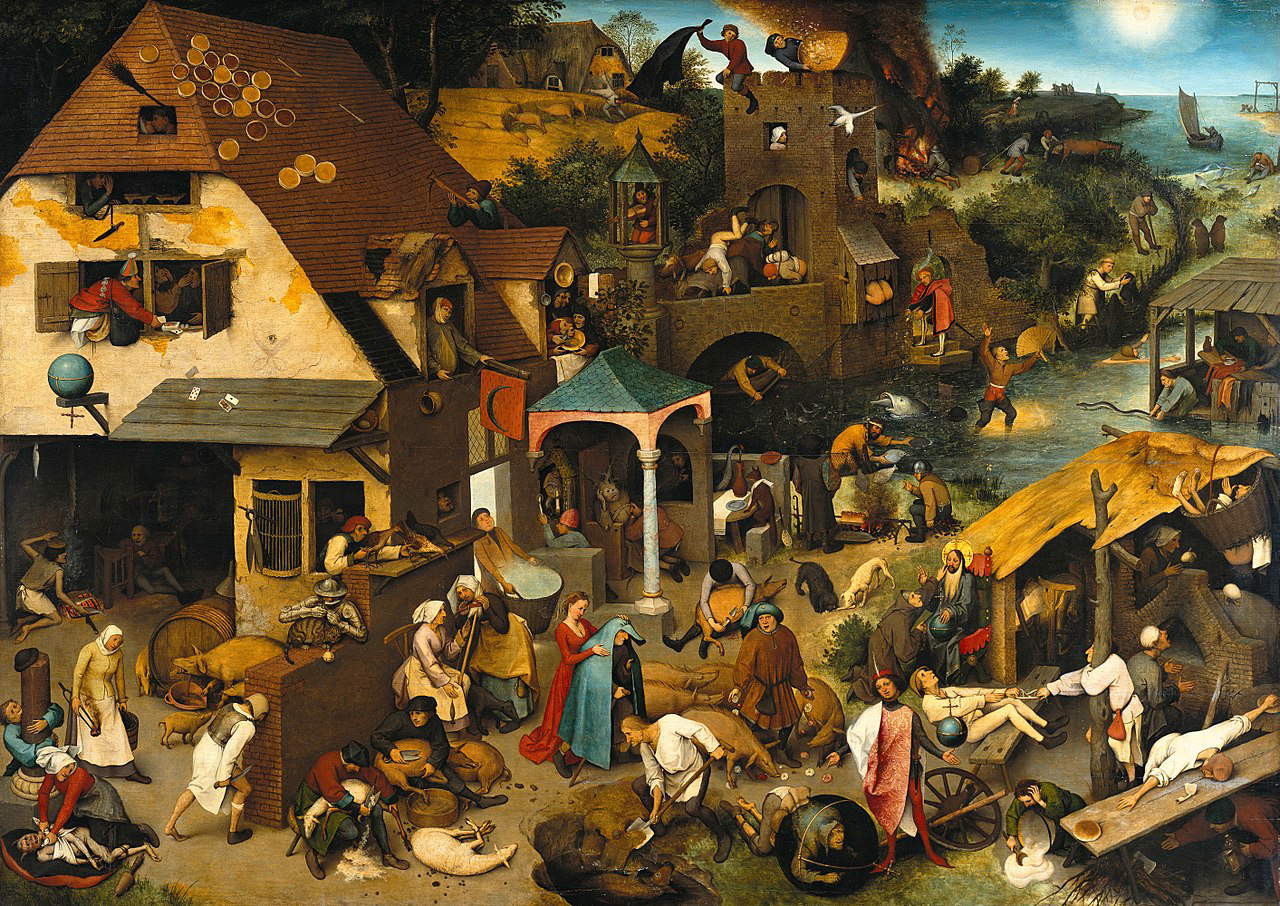 |
| Pieter Bruegel, Flemish Proverbs (1559; oil on panel, 117 x 163 cm; Berlin, Staatliche Museen, Gemäldegalerie) |
Here, however, scholars’ observation has prevailed over attention to the extraordinary skill with which Bruegel, before anything else, renders the essence of a cold winter day.
Instead of the yellowish hue that the fog-laden sky and its reflection have in Winter Landscape with Skaters and Bird Trap, in the painting of the Cycle of Months we find a scenery enveloped in a crystalline atmosphere in which everything seems suspended, pervaded by a deep sense of loneliness and by the silence of winter’s rigor, even the distant figures of the skaters. And then the impression of cold that is in every detail: in the fatigued steps of the hunters, in the bare black branches scratching the white of the snow, and in the livid green of the sky.
The breadth of the landscape is emphasized by the succession of logs in the foreground that accompany the eye toward the curve drawn by the valley and then upward again from the mountain peaks to the left. As mentioned, the setting is probably, at least in part, the result of reminiscences of the alpine landscapes that Bruegel had the opportunity to admire, but the attempted identification of these places with precise locations is not generally accepted.
Wied again writes, referring to the entire cycle and to Hunters in the Snow in particular, “Here more than elsewhere it is evident how much these landscapes aim at the universal. It is not just any winter landscape, it is instead its complex, the winter par excellence.”
Warning: the translation into English of the original Italian article was created using automatic tools. We undertake to review all articles, but we do not guarantee the total absence of inaccuracies in the translation due to the program. You can find the original by clicking on the ITA button. If you find any mistake,please contact us.